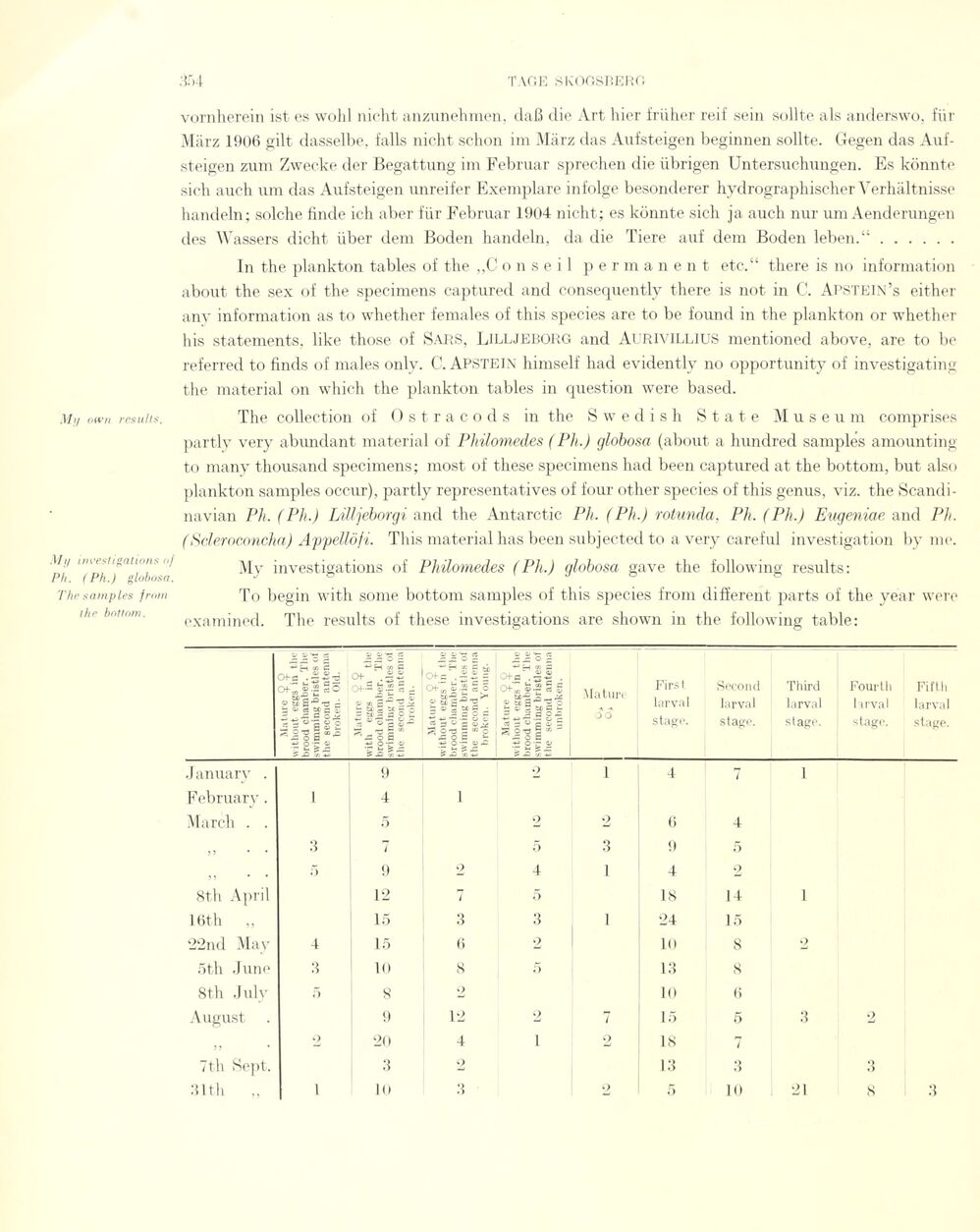
Full resolution (JPEG) - On this page / på denna sida - Sidor ...

<< prev. page << föreg. sida << >> nästa sida >> next page >>
Below is the raw OCR text
from the above scanned image.
Do you see an error? Proofread the page now!
Här nedan syns maskintolkade texten från faksimilbilden ovan.
Ser du något fel? Korrekturläs sidan nu!
This page has never been proofread. / Denna sida har aldrig korrekturlästs.
Mi/ own results.
Mi/ investigations vj
Ph. (Ph.) globosa.
The samples from
the bottom.
vornherein ist es wohl nicht anzunehmen, daß die Art hier früher reif sein sollte als anderswo, für
März 1906 gilt dasselbe, falls nicht schon im März das Aufsteigen beginnen sollte. Gegen das
Aufsteigen zum Zwecke der Begattung im Februar sprechen die übrigen Untersuchungen. Es könnte
sich auch um das Aufsteigen unreifer Exemplare infolge besonderer hydrographischer Verhältnisse
handeln; solche finde ich aber für Februar 1904 nicht; es könnte sich ja auch nur um Aenderungen
des Wassers dicht über dem Boden handeln, da die Tiere auf dem Boden leben.“...................
In the plankton tables of the ,,C o n s e i 1 permanent etc.“ there is no information
about the sex of the specimens captured and consequently there is not in C. Apstein’s either
any information as to whether females of this species are to be found in the plankton or whether
his statements. like those of Sars, Lilljeborg and AURIVILLIUS mentioned above, are to be
referred to finds of males only. C. Apstein himself had evidently no opportunity of investigating
the material on which the plankton tables in question were based.
The collection of Ostracods in the Swedish State Museum comprises
partly very abundant material of Philomedes (Ph.) globosa (about a hundred samples amounting
to many thousand specimens; most of these specimens had been captured at the bottom, but also
plankton samples occur), partly representatives of four other species of this genus, viz. the
Scandinavian Ph. (Ph.) Lilljeborgi and the Antarctic Ph. (Ph.) rotunda, Ph. (Ph.) Eugeniae and Ph.
( Scleroconcha) Appello fi. This material has been subjected to avery careful investigation by me.
My investigations of Philomedes (Ph.) globosa gave the following results:
To begin with some bottom samples of this species from different parts of the year were
examined. The results of these investigations are shown in the following table:
Mature Ç Ç without eggs in the brood chamber. The swimming bristles of the second antenna j broken. Old. o) Q) ‘j* eS H 5 ,S| Oh-™ c® c: ; v & 2 ^ "2 te ri bc X O ~ tt s ap: n "go* »H ^ C IC •1111 Mature Ç $ without eggs in the brood chamber. The swimming bristles of the second antenna broken. Young. Mature Ç Ç without eggs in the brood chamber. The swimming bristles of the second antenna unbroken. Mature -A s OO First, larval Stage. Second larval stage. Third larval stage. Fourth Fif th larval larval stage. stage.
January . 9 2 1 4 7 1
February. i 4 i
March . . *;> 5 2 2 o 6 4
3 5 * 33 * f) t 9 2 4 1 4 Ô 2
8th April 12 7 5 18 14 1
16th ,, 15 3 3 1 24 15
22nd May 4 15 6 2 10 8 2
5th June 8 lo 8 5 13 8
8th J uly 5 8 2 10 6
August 9 12 2 / 15 5 3 2
33 o 20 4 1 2 18 /
7th Sept. 3 2 13 3 3
:mh „ i 10 3 2 5 10 21 8 3
<< prev. page << föreg. sida << >> nästa sida >> next page >>